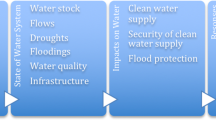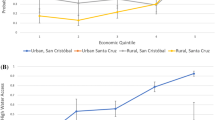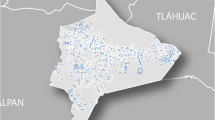Abstract
The health consequences of disaster recovery efforts are rarely evaluated comprehensively. With increases in public spending usually accompanying claims by aid agencies and national governments about improving resilience, the potential impacts of reconstruction processes on public health deserve a closer look. This study focuses on the region of Indonesia that was hit hardest by the massive 2004 tsunami and was then the epicenter of an unprecedented recovery effort. I turn to data from a unique longitudinal survey to evaluate multiple dimensions of water access for almost 6000 families over 10 years. Using logit and multinomial logit regression analysis, I demonstrate that richer households increasingly access higher quality water sources, while poorer households disproportionately turn to lower-quality sources. This result has important implications for health outcomes and for our understanding of how vulnerability extends past the moment of a disaster.





Similar content being viewed by others
Notes
Analyses have also been conducted on a larger sample that includes household “split-offs” – family members that departed one household to form another. No conclusions are challenged by these supplemental findings, which are available upon request.
Consistent with local context, I assume throughout the analysis to follow that some natural source (spring, river, rainwater) is available to each household.
The panel sample for regression is slightly smaller than the descriptive sample because of item non-response.
References
Affan, M., et al. (2015). Lessons learned from two villages in the tsunami most affected area of Banda Aceh City; a review of the housing reconstruction and the current state of village development. In V. Santiago-Fandiño, Y. Kontar, & Y. Kaneda (Eds.), Post-Tsunami Hazard. Advances in Natural and Technological Hazards Research (Vol. 44). Cham: Springer.
Albala-Bertrand, J.-M. (1993) Political economy of large natural disasters: with special reference to developing countries. OUP Catalogue.
American Red Cross. (2006). Two Year Report: Tsunami Recovery Program.
Ashbolt, N. J. (2004). Microbial contamination of drinking water and disease outcomes in developing regions. Toxicology, 198(1), 229–238.
Baker, J. L. (2012). Climate change, disaster risk, and the urban poor: cities building resilience for a changing world. Washington, DC: World Bank.
Bakker, K. (2007). Trickle down? Private sector participation and the pro-poor water supply debate in Jakarta, Indonesia. Geoforum, 38(5), 855–868.
Bakker, K. (2008). The ambiguity of community: Debating alternatives to private sector provision of urban water supply. Water Alternatives, 1(2), 236.
Bonita, R., Beaglehole, T., & Kjellstrom, R. (2006). Basic epidemiology (2nd ed.). World Health Organization.
Braadbaart, O., & Braadbaart, F. (1997). Policing the urban pumping race: industrial groundwater overexploitation in Indonesia. World Development, 25(2), 199–210.
Braveman, P., Egerter, S., & Williams, D. R. (2011). The social determinants of health: coming of age. Annual Review of Public Health, 32, 381–398.
Brown, J., Hamoudi, A., Jeuland, M., & Turrini, G. (2017). Seeing, believing, and behaving: heterogeneous effects of an information intervention on household water treatment. Journal of Environmental Economics and Management, 86, 141–159.
BRR NAD-NIAS. (2006). Aceh and Nias one year after the tsunami: the recovery effort and way forward.
BRR NAD-NIAS. (2010). 10 management lessons for host governments coordinating post-disaster reconstruction.
Cameron, A. C., & Miller, D. L. (2015). A Practitioner’s guide to cluster-robust inference. The Journal of Human Resources, 50(2), 317–372.
Cheng, J. J., Schuster-Wallace, C. J., Watt, S., Newbold, B. K., & Mente, A. (2012). An ecological quantification of the relationships between water, sanitation and infant, child, and maternal mortality. Environmental Health, 11(1), 4.
Clasen, T., Smith, L., Albert, J., Bastable, A., & Fesselet, J.-F. (2006). The drinking water response to the Indian Ocean tsunami, including the role of household water treatment. Disaster Prevention and Management: An International Journal, 15(1), 190–201.
Clasen, T., Schmidt, W.-P., Rabie, T., Roberts, I., & Cairncross, S. (2007). Interventions to improve water quality for preventing diarrhoea: systematic review and meta-analysis. Bmj, 334(7597), 782.
Connor, R. (2015). The United Nations world water development report 2015: water for a sustainable world. UNESCO publishing.
Cutler, D., & Miller, G. (2005). The role of public health improvements in health advances: the twentieth-century United States. Demography, 42(1), 1–22.
Devoto, F., Duflo, E., Dupas, P., Parienté, W., & Pons, V. (2012). Happiness on tap: piped water adoption in urban Morocco. American Economic Journal: Economic Policy, 4(4), 68–99.
Duffield, M. (2005). Social reconstruction: the reuniting of aid and politics. Development, 48(3), 16–24.
Engelhardt, A., Hidalgo, S., & Sole, R. (2006). The international community’s funding of the tsunami emergency and relief: government funding synthesis. London: Tsunami Evaluation Coalition.
Erikson, K.T. (1976). Everything in its path: Simon and Schuster.
Fewtrell, L., Kaufmann, R. B., Kay, D., Enanoria, W., Haller, L., & Colford, J. M., Jr. (2005). Water, sanitation, and hygiene interventions to reduce diarrhoea in less developed countries: a systematic review and meta-analysis. The Lancet Infectious Diseases, 5(1), 42–52.
Frankenberg, E., Gillespie, T., Preston, S., Sikoki, B., & Thomas, D. (2011). Mortality, the family and the Indian Ocean tsunami. The Econometrics Journal, 121(554), F162–F182.
Freudenberg, W. R., Gramling, R. B., Laska, S., & Erikson, K. (2009). Catastrophe in the making: the engineering of Katrina and the disasters of tomorrow. Island press.
Giles, H., & Brown, B. (1997). 'And not a drop to drink': water and sanitation services to the urban poor in the developing world. Geography, 97–109.
Hadipuro, W. (2010). Indonesia’s water supply regulatory framework: between commercialisation and public service? Water Alternatives, 3(3), 475–491.
Hewitt, K. (1983). The idea of calamity in a technocratic age. In Interpretations of calamity: from the viewpoint of human ecology. Unwin Hyman.
Jayasuriya, S., McCawley, P. (2008). Reconstruction after a major disaster: lessons from the post-tsunami experience in Indonesia, Sri Lanka, and Thailand. ADBI working paper series.
Kennedy, J., Ashmore, J., Babister, E., & Kelman, I. (2008). The meaning of ‘build back better’: evidence from post-tsunami Aceh and Sri Lanka. Journal of Contingencies & Crisis Management, 16, 24–36.
Khasalamwa, S. (2009). Is ‘build back better’ a response to vulnerability? Analysis of the post-tsunami humanitarian interventions in Sri Lanka. Norwegian Journal of Geography, 63(1), 73–88.
Komarulzaman, A., de Jong, E., & Smits, J. (2017). The switch to refillable bottled water in Indonesia: a serious health risk. Journal of Water and Health, 15(6), 1004–1014.
Kremer, M., Leino, J., Miguel, E., & Zwane, A. P. (2007). Spring cleaning: a randomized evaluation of source water quality improvement. Quarterly Journal of Economics, 4(2), 09–30.
Lenton, R., Lewis, K., & Wright, A. (2008). Water, sanitation and the millennium development goals. Journal of International Affairs, 61(2), 247–258.
Lundine, J., Hadikusumah, R., Sudrajat, T. (2013). Indonesia’s progress on the 2015 millennium development goals. strategic view Indonesia. July-September 3.
Matsumaru, R., Nagami, K., & Takeya, K. (2012). Reconstruction of the Aceh region following the 2004 Indian Ocean tsunami disaster: a transportation perspective. IATSS Research, 36(1), 11–19.
McMahon, P., Nyheim, T., & Schwarz, A. (2006). After the tsunami: lessons from reconstruction. The McKinsey Quarterly, 1, 94.
PAHO. (2006). The challenge in disaster reduction for the water and sanitation sector. Pan-American Health Organization. PAHO HQ Library Cataloguing-in-Publication.
Pattanayak, S. K., Yang, J. C., Whittington, D., & Bal Kumar, K. (2005). Coping with unreliable public water supplies: averting expenditures by households in Kathmandu, Nepal. Water Resources Research, 41(2).
Prasetiawan, T. , Nastiti, A. & Muntalif, B. S. (2017). ‘Bad’ piped water and other perceptual drivers of bottled water consumption in Indonesia. WIREs Water, 4, 19.
Prüss, A., Kay, D., Fewtrell, L., & Bartram, J. (2002). Estimating the burden of disease from water, sanitation, and hygiene at a global level. Environmental Health Perspectives, 110(5), 537.
Reid, A. (2004). War, peace and the burden of history in Aceh. Asian Ethnicity, 5(3), 301–314.
Rheingans, R., Dreibelbis, R., & Freeman, M. (2006). Beyond the millennium development goals: public health challenges in water and sanitation. Global Public Health, 1(1), 31–48.
Rubin, C. B. (1985). The community recovery process in the United States after a major natural disaster. International Journal of Mass Emergencies and Disasters, 3, 29–28.
Sachs, J. D., & McArthur, J. W. (2005). The millennium project: a plan for meeting the millennium development goals. Lancet, 365(9456), 347.
Shaw, R. (2008). Aceh’s struggle for independence: considering the role of Islam in a separatist. Al Nakhlah: The Fletcher School Online Journal on Southwest Asia and Islamic Civilization, 1–14.
Sikoki, B., Sumantri, C., Suriastini, W. (2008) Methods of tracking the displaced: lesson from the study of the tsunami aftermath and recovery. Presented at the annual PAA meetings, April 17–19, New Orleans, LA.
Telford, J., & Cosgrave, J. (2006). Joint evaluation of the international response to the Indian Ocean tsunami. Tsunami Evaluation Coalition; Joint Evaluation, 2006, 1.
Telford, J., & Cosgrave, J. (2007). The international humanitarian system and the 2004 Indian Ocean earthquake and tsunamis. Disasters, 31(1), 1–28.
UN. (2000). United Nations millennium declaration. United Nations General Assembly.
UN. (2010). Resolution adopted by the General Assembly on 28 July 2010: The human right to water and sanitation.
UNICEF. (2015). Progress on sanitation and drinking water – 2015 update and MDG assessment. WHO Library Cataloguing-in-Publication Data.
UNISDR. (2018). What is disaster risk reduction?” https://www.unisdr.org/who-we-are/what-is-drr. Accessed 24 Apr 2018.
USAID. 2016. Recovering from crisis. https://www.usaid.gov/what-we-do/working-crises-and-conflict/recovering-crisis. Accessed 24 Apr 2018.
World Bank. (2014). Managing disaster’s risks for resilient development. http://projects-beta.worldbank.org/en/results/2013/04/12/managing-disaster-risks-resilient-development. Accessed 16 Apr 2018.
World Health Organization. (1996). Guidelines for drinking-water quality. Vol. 2, health criteria and other supporting information.
Author information
Authors and Affiliations
Corresponding author
Additional information
Publisher’s note
Springer Nature remains neutral with regard to jurisdictional claims in published maps and institutional affiliations.
Rights and permissions
About this article
Cite this article
Burrows, M. Water access in post-tsunami Indonesia. Popul Environ 40, 411–433 (2019). https://doi.org/10.1007/s11111-019-00318-5
Published:
Issue Date:
DOI: https://doi.org/10.1007/s11111-019-00318-5




